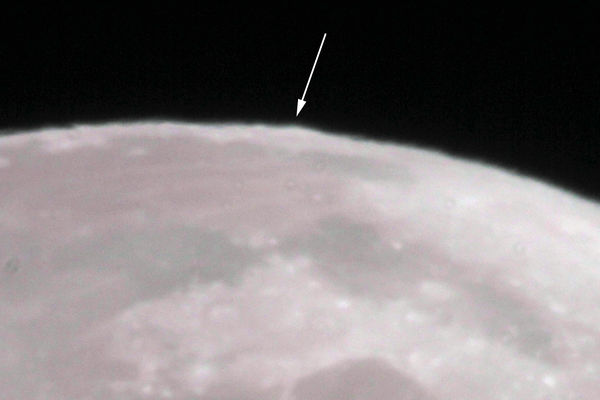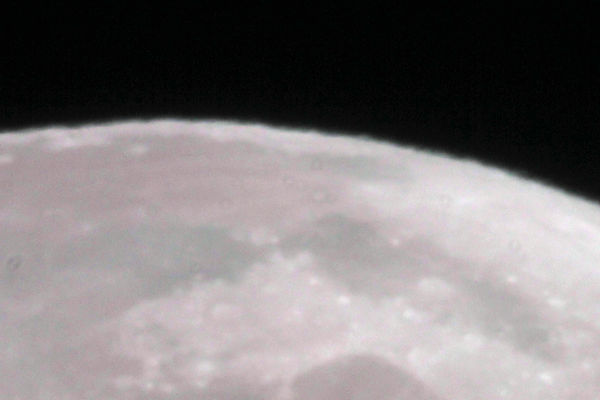Note on Seeing Conditions
Dec 9, 2014 21:55:01 #
Here are two images taken back to back less than a second apart. It shows dramatically what the term "Bad Seeing" is and can do to your photos of the moon. Both exposures are 1/125 sec at ISO 400 shot at f/9 through an Astro-Tech 6-inch Ritchey-Chretien telescope.
In the first image notice the large mountain seen in profile along the limb of the moon (arrowed). In the very next shot it is gone and a depression now appears. These images were shot over some pine trees, and yes they will hold in some heat. Even your on body heat if you are standing downwind, or is it upwind, whichever, if the wind is blowing from your body toward the opening of the telescope will also create bad seeing. This is the main reason that astronomers both professional and amateurs will use long cables to isolate the telescope from themselves. The larger the instrument the more pronounced this effect is. One way to demonstrate it is to place a very out of focus star in live view of your camera and place your hand near the lens of the telescope or telephoto lens. Do this on an extremely cold night and you can actually see the heat currents. It resembles the heat currents one sees in the summertime on a hot pavement. By moving away from your instrument as much as possible as well as avoiding buildings, pine trees, pavement etc, your high resolution images should improve greatly. If you are shooting the moon, try to image it when it is at it's highest point in the sky. The lower you get to the horizon the greater the turbulence is in the atmosphere. Sort of like shooting something underwater looking up. I hope this helps in explaining one of the problems astrophotographers face and will help with those moon photos. One last point, if you happen upon a night when the stars are "not" twinkling and the moon is out, go for it because the atmosphere is steady.
In the first image notice the large mountain seen in profile along the limb of the moon (arrowed). In the very next shot it is gone and a depression now appears. These images were shot over some pine trees, and yes they will hold in some heat. Even your on body heat if you are standing downwind, or is it upwind, whichever, if the wind is blowing from your body toward the opening of the telescope will also create bad seeing. This is the main reason that astronomers both professional and amateurs will use long cables to isolate the telescope from themselves. The larger the instrument the more pronounced this effect is. One way to demonstrate it is to place a very out of focus star in live view of your camera and place your hand near the lens of the telescope or telephoto lens. Do this on an extremely cold night and you can actually see the heat currents. It resembles the heat currents one sees in the summertime on a hot pavement. By moving away from your instrument as much as possible as well as avoiding buildings, pine trees, pavement etc, your high resolution images should improve greatly. If you are shooting the moon, try to image it when it is at it's highest point in the sky. The lower you get to the horizon the greater the turbulence is in the atmosphere. Sort of like shooting something underwater looking up. I hope this helps in explaining one of the problems astrophotographers face and will help with those moon photos. One last point, if you happen upon a night when the stars are "not" twinkling and the moon is out, go for it because the atmosphere is steady.
Dec 10, 2014 09:03:40 #
dlmorris
Loc: Loma Linda, Ca
Very good explanation. You don't want to stand *upwind* of your telescope! Those of us who have observatories can have problems, because they can retain heat for a long time, causing those pesky heat waves.... It's also why the sun telescope on Mt. Wilson is up on a high tower, and the solar telescope in Big Bear, California, is situated out on the lake itself..
Dec 10, 2014 11:35:27 #
dlmorris wrote:
Very good explanation. You don't want to stand *upwind* of your telescope! Those of us who have observatories can have problems, because they can retain heat for a long time, causing those pesky heat waves.... It's also why the sun telescope on Mt. Wilson is up on a high tower, and the solar telescope in Big Bear, California, is situated out on the lake itself..
Yes it can be a problem in an observatory especially the dome type, but that's why professional observatories are air conditioned. They bring the temp down to match the forecast and they usually have a separate control room as well.
I had a 16-inch Newtonian on a fork mount. when pointing straight up (zenith), the bottom of the tube was only about two feet off the floor. Standing next to it would cause radiant heat from your body to distort the image. I learned to move at least ten feet away.
Have been to Big Bear and Mt. Wilson as well as Kitt Peak. Wonderful instruments all. Those solar telescopes are all extremely high resolution instruments and the images of white light sunspots they all produce are breath taking.
Dec 10, 2014 17:55:19 #
Algol wrote:
Here are two images taken back to back less than a... (show quote)
Thank you very much Algo for this lesson.
I usually wait till after 11:00PM to photograph when the year cools off but I never even considered my own body heat, which make great sense as being a problem.
Craig
Dec 17, 2014 18:08:48 #
If you want to reply, then register here. Registration is free and your account is created instantly, so you can post right away.




